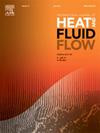Unsteady Reynolds-Averaged Navier-Stokes simulation of turbulent flow fields around a line of trees and a steep hill using a new turbulent inflow generation method
IF 2.6
3区 工程技术
Q2 ENGINEERING, MECHANICAL
International Journal of Heat and Fluid Flow
Pub Date : 2024-12-27
DOI:10.1016/j.ijheatfluidflow.2024.109705
引用次数: 0
Abstract
In this study, mean and turbulent flow fields around a line of trees and a steep hill are investigated by unsteady Reynolds-Averaged Navier-Stokes (URANS) simulation with a new turbulent inflow generation method. First, an inflow generation method is presented for the URANS model, utilizing a prespecified averaging time to divide the turbulent flow fields into resolved and modelled parts and ensure conservation of the total turbulence kinetic energy. The turbulent flow fields reproduced by the URANS model are then evaluated over flat terrain, a line of trees and a steep hill to demonstrate the performance of the URANS model. A large averaging time can be applied to the URANS model for flat terrain and a line of trees because the turbulent flow field can be simulated well by the turbulence model, but suitable averaging times are required for the URANS simulation to predict large separation vortices behind the steep hill as resolved coherent structures. Finally, an indicator is proposed to assess the performance of turbulence models considering the prediction accuracy and computational efficiency. The proposed method exhibits the best performance in predicting the mean velocity and turbulence kinetic energy, compared to Reynolds-Averaged Navier-Stokes model and Large Eddy Simulation.
求助全文
约1分钟内获得全文
求助全文
来源期刊

International Journal of Heat and Fluid Flow
工程技术-工程:机械
CiteScore
5.00
自引率
7.70%
发文量
131
审稿时长
33 days
期刊介绍:
The International Journal of Heat and Fluid Flow welcomes high-quality original contributions on experimental, computational, and physical aspects of convective heat transfer and fluid dynamics relevant to engineering or the environment, including multiphase and microscale flows.
Papers reporting the application of these disciplines to design and development, with emphasis on new technological fields, are also welcomed. Some of these new fields include microscale electronic and mechanical systems; medical and biological systems; and thermal and flow control in both the internal and external environment.
 求助内容:
求助内容: 应助结果提醒方式:
应助结果提醒方式:


